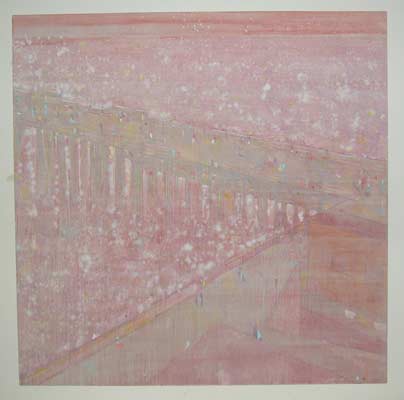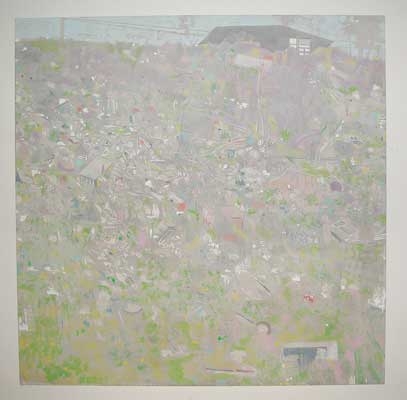
Untitled (Mexico Park), 2003.
Acrylic, colored pencil on canvas,
72" x 72".
David Kortyby Donald Goddard |
 Untitled (Mexico Park), 2003. Acrylic, colored pencil on canvas, 72" x 72". |
Such an old medium, the canvas, especially when considered on a continuum from the weavings of ancient Anatolia and Peru through medieval tapestries to the paintings of Rembrandt, Turner, and Pollock. In its enormous variety, the use of cloth in art has a peculiarly personal quality. A painting on canvas or a woven design, invariably, like clothing, belongs first to the person or people who worked on it and to those for whom it is made, whereas a rock drawing, cave painting, or church fresco belongs to, is part of, the place for which it was created, as is a manuscript painting, the context in that case being text. Even tapestries dealing with great mythological and historical themes and covering vast areas of church or castle walls, are essentially domestic and personal rather than communal and institutional, in part because they are collapsible and portable. They are the realm of personal fantasy, weaving other times, spaces, and lives into ours. |
 Untitled (Santa Monica Pier), 2003. Acrylic, colored pencil on canvas, 72" x 72". |
Mostly, artists didn't paint on canvas until the 16th century, the age of humanism, when religion, in a manner of speaking, also became more personal. The canvas is the place wherein the world is re-created, in all its diversity, or spareness, in the form of a person's idea or vision, whether representational or abstract. It is more like a diaphragm than a window or mirror, a diaphanous membrane that contains the fullness of seeing and thinking and breathing. In David Korty's paintings one is aware of the canvas as this kind of place, where the precision of imagery - of cars, houses, garbage, trees, people - of recognizable views in and around Los Angeles, is merged with an abstraction of means - of geometric shapes, linear structures, brushstokes - to occupy with extraordinary presence that same frail membrane. The opacity of the photographs from which these views derive dissolves into the transparency of applied structure and color as they exist not covering but stained into the weave of the canvas itself. Paint and compositions have lives separate from yet intimately bound to the images, so that what comes from the artist's hand and mind are the images. |
 Untitled (Garbage on a Hillside), 2003. Acrylic, colored pencil on canvas, 72" x 72". |
It's a matter of transformation. There is hardly
a measure of time for what appears to be, though photographs seem to stop time.
But we know that what is in a photograph no longer exists - those cars parked
just where they are, or especially the people in line at a mall - nor did it
exist before the photograph was taken. The mind has a similar remembrance of
things, but of course it is not at all either in the language of the photograph
or of the material world it remembers. Korty's parks, streets, rivers, malls,
and piers exist, more emphatically than most paintings because there are no extrinsic
(sentimental?) objectives, in remembrance but in full recognition that everything
changes before, after, and throughout, most ostentatiously the light that infuses
every object. The people in Untitled (Mexico Park) are, like everything
else, ghost images but nonetheless images of very particular human beings. The
angled structure of Untitled (Santa Monica Pier) could disappear, but
it would still exist. The house in Untitled (Garbage on a Hillside) almost
does disappear, but it is essential to the image of being overwhelmed and buried.
It's sort of the obverse side of mythology where nothing is made up but all will
eventually return to be contained in a condition of white light (not darkness).
Donald Goddard © 2004 |
Art Review - NYArtWorld.com - NYAW.com. All artwork is copyright of the respective owner or artist. All other material © Copyright 2015 New York Art World ®. All Rights Reserved.
New York Art World ® - Back to Top